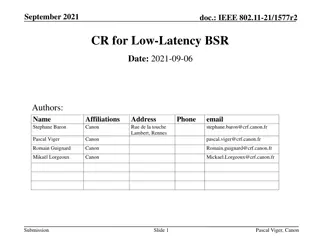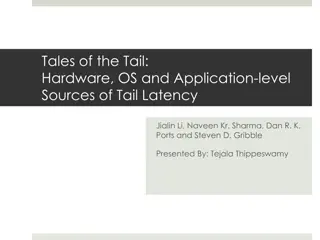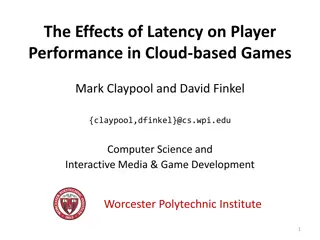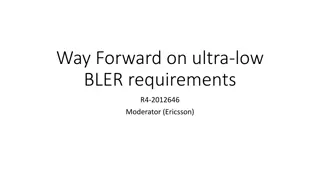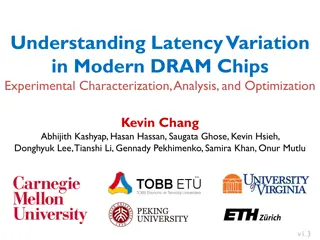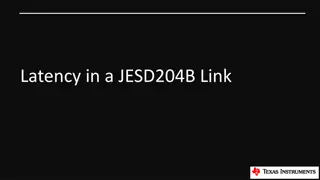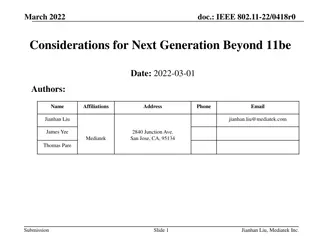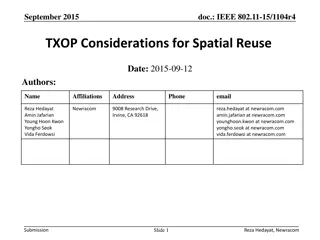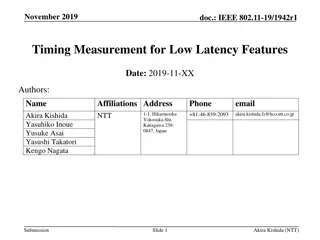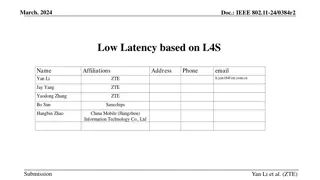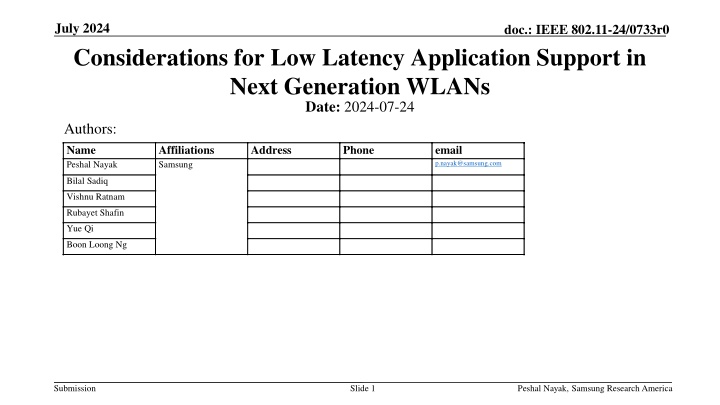
Enhancing Low Latency Support in Next Generation WLANs
Explore ways to enhance support for low-latency applications in next-generation WLANs through methods like TXOP limit reduction and enhanced EDCA operation. Addressing channel access delays is crucial for achieving better latency performance, especially for emerging applications like cloud gaming, AR/VR, industrial automation, and more. Considerations for different ranges of delay tolerance and feature requirements for supporting various low-latency applications are discussed.
Download Presentation

Please find below an Image/Link to download the presentation.
The content on the website is provided AS IS for your information and personal use only. It may not be sold, licensed, or shared on other websites without obtaining consent from the author. If you encounter any issues during the download, it is possible that the publisher has removed the file from their server.
You are allowed to download the files provided on this website for personal or commercial use, subject to the condition that they are used lawfully. All files are the property of their respective owners.
The content on the website is provided AS IS for your information and personal use only. It may not be sold, licensed, or shared on other websites without obtaining consent from the author.
E N D
Presentation Transcript
July 2024 doc.: IEEE 802.11-24/0733r0 Considerations for Low Latency Application Support in Next Generation WLANs Date: 2024-07-24 Authors: Name Peshal Nayak Affiliations Samsung Address Phone email p.nayak@samsung.com Bilal Sadiq Vishnu Ratnam Rubayet Shafin Yue Qi Boon Loong Ng Submission Slide 1 Peshal Nayak, Samsung Research America
July 2024 doc.: IEEE 802.11-24/0733r0 Abstract EDCA continues to serve as the primary channel access method for Wi-Fi networks and will likely maintain this status well into the future. Channel access delay plays a crucial role in determining the achievable latency performance. In this contribution, we explore ways to enhance low latency application support via TXOP limit reduction Enhanced EDCA based operation These methods hold potential for enhancing support for low-latency applications [1-3] Submission Slide 2 Peshal Nayak, Samsung Research America
July 2024 doc.: IEEE 802.11-24/0733r0 Support for New LL Applications in Wi-Fi There has been a growing interest to provide enhanced support in Wi-Fi for a number of emerging applications. Cloud gaming, AR VR, industrial automation[4-6], etc. A number of these applications typically have low throughput but extremely tight latency requirements [7-10] E.g., inter-packet/burst arrival period of 100+ millseconds but packets need to be sent with a few milliseconds upon enqueue. Submission Slide 3 Peshal Nayak, Samsung Research America
July 2024 doc.: IEEE 802.11-24/0733r0 Channel Access Delays The Next Frontier! DIFS + 27 s DIFS + 18 s DIFS + 27 s 36 s 5 ms 5 ms 5 ms STA 1 Defer to STA2 s transmission Defer to STA3 s transmission Defer to STA4 s transmission STA1 STA10 End of successful transmission LL packet arrival BO: 12 Channel access delay STA2 STA3 A key bottleneck that determines achievable latency is the channel access delay. Factors such as amount of time spent deferring to other transmissions, backoff counters, etc. contribute to tail latency in Wi-Fi. Reducing the time taken by such factors can enhance support for low latency applications. Which factor to address in the solution depends on the range in which the application latency requirement falls. Submission Slide 4 Peshal Nayak, Samsung Research America
July 2024 doc.: IEEE 802.11-24/0733r0 No One-Size-Fits-All Solution Analysis of feature requirement for LL applications Range for delay tolerance d = delay tolerance, CA = legacy channel access delay Example values of d Example applications Feature requirements 1. d TXOP limit Few Real time gaming, AR/VR Enable packet transmission before the end of the TXOP. E.g., preemption (Not addressed in this contribution) milliseconds 2. TXOP limit < d CA Close to 10 milliseconds Real time gaming, AR/VR, cloud gaming, some real time video applications, robotics, industrial automation, etc. Traffic may survive not being served in the same TXOP where it arrives but cannot incur a long channel access delay. Solution that can enable channel access faster than legacy channel access are needed 3. CA delay << d Few 10s of milliseconds Video call, audio call, non-real time services such as streaming, web browsing, file downloads, etc. Legacy channel access (Not address in this contribution) Submission Slide 5 Peshal Nayak, Samsung Research America
July 2024 doc.: IEEE 802.11-24/0733r0 Problem Illustration DIFS + 27 s DIFS + 18 s DIFS + 27 s 36 s 5 ms 5 ms 5 ms STA 1 Defer: STA3 TX/RX Defer: STA4 TX/RX Defer: STA2 TX/RX STA1 STA10 Time when STA1 can get channel access App 1: 10 ms latency Packet expiration LL packet arrival BO: 12 STA3 STA2 App 3: 50 ms latency App 2: 40 ms latency Application in case 2 cannot incur a long channel access delay. Solutions that can enable channel access faster than legacy channel access are needed Submission Slide 6 Peshal Nayak, Samsung Research America
July 2024 doc.: IEEE 802.11-24/0733r0 Solution Approach Auth. for Enhanced EDCA DIFS + 9 s DIFS + 18 s 2 ms 36 s 2 ms Time when STA1 can get channel access STA 1 STA1 STA2 TX/RX STA3 TX/RX App1: 10ms latency LL packet arrival BO: 7 Packet expiration STA3 STA2 App 3: 50 ms latency App 2: 40 ms latency In this contribution, we explore two approaches that can be used jointly to solving this problem: 1. Reduction of TXOP limits: controlling amount of defer time to other devices. 2. Enhanced EDCA: authorize device running case 2 LL application with an EDCA parameter set that enables it to access channel faster than legacy channel access. Submission Slide 7 Peshal Nayak, Samsung Research America
July 2024 doc.: IEEE 802.11-24/0733r0 High Level Procedure AP STA High Level Procedure: STA can inform the AP about its LL requirements. E.g., via SCS setup If STA fits in case 2, AP can authorize the STA for enhanced EDCA and provide the STA with an EDCA parameter set that results in higher priority to the wireless medium. AP can further reduce TXOP limits for other STAs in the network. AP/STA can terminate the authorization for the STA when necessary. E.g., when case 2 LL app session ends. LL session setup Auth. for enhanced EDCA. AP shares a new EDCA parameter set Channel access with enhanced EDCA parameter set AP can reduce TXOP limits if necessary Authorization termination STA returns to normal EDCA parameters Submission Slide 8 Peshal Nayak, Samsung Research America
July 2024 doc.: IEEE 802.11-24/0733r0 Discussion on TXOP Limit Reduction There can be some challenges with TXOP limit reduction It can limit the throughput of high throughput applications. Some 11ac and prior implementations are known to ignore TXOP limits advertised by the AP [4]. But Its under AP s control. AP can tune it based on the requirements of different devices. Also, bulk bytes are transmitted on the downlink. AP limiting the TXOP for the downlink can already handle a lot of cases. Submission Slide 9 Peshal Nayak, Samsung Research America
July 2024 doc.: IEEE 802.11-24/0733r0 Discussion About Enhanced EDCA Parameter Set The design principle is already used in Wi-Fi 7 for EPCS to achieve a similar objective. How can this jointly work with EPCS? The proposed framework operates under AP s guidance. AP is also involved in EPCS authorization. AP can take steps to ensure no harm occurs to EPCS operation. E.g., de-authorize LL device for enhanced EDCA parameter set. But this is expected to be a rare occurrence. Submission Slide 10 Peshal Nayak, Samsung Research America
July 2024 doc.: IEEE 802.11-24/0733r0 Conclusion 11bn should consider enhancements for EDCA for better support of even lower latency applications. In this contribution, we discuss requirements for LL applications based on the delay requirement range. We propose solutions based on extension of legacy procedures: TXOP limit reduction coupled with Enhanced EDCA operation Submission Slide 11 Peshal Nayak, Samsung Research America
July 2024 doc.: IEEE 802.11-24/0733r0 Straw Poll 1 Do you agree to improve EDCA to reduce tail access delay of low latency traffic? Note: The solution can operate under the guidance/supervision of the AP to limit impact to legacy use cases. Yes No Abstain Submission Slide 12 Peshal Nayak, Samsung Research America
July 2024 doc.: IEEE 802.11-24/0733r0 Straw Poll 2 Do you agree that the AP can authorize select STAs to use an enhanced EDCA parameter set to reduce channel access delays? Yes No Abstain Submission Slide 13 Peshal Nayak, Samsung Research America
July 2024 doc.: IEEE 802.11-24/0733r0 References [1] Szott, Szymon, et al. "Impact of contention window cheating on single-hop IEEE 802.11 e MANETs." IEEE WCNC, 2008. [2] Szott, Szymon, Marek Natkaniec, and AndrzejR Pach. "An IEEE 802.11 EDCA model with support for analysing networks with misbehaving nodes." EURASIP Journal, 2010. [3] Z. Lu, W. Wang and C. Wang, "On Order Gain of Backoff Misbehaving Nodes in CSMA/CA-based Wireless Networks," 2010 Proceedings IEEE INFOCOM, 2010 [4] Consideration of Industrial Automation Scenarios, IEEE 802.11-23/0815 [5] Discussion on bounded delay in Industrial Scenarios, IEEE 802.11-24,0443 [6] Cloud VR Use Case and Requirements, IEEE 802.11-22/0952 [7] Polupanova, Marina. "VR Traffic Dataset on Broad Range of End-User Activities." Data 8.8 (2023): 132. [8] Salehi, S.; Alnajim, A.; Zhu, X.; Smith, M.; Shen, C.C.; Cimini, L. Traffic Characteristics of Virtual Reality over Edge-enabled Wi-Fi Networks. 2020. [9] Cheng, Ruizhi, et al. "Are we ready for metaverse? A measurement study of social virtual reality platforms." ACM IMC 2022. [10] STA TXOP Frame Bursting Testing, WFA, 2020 [11] A Custura, R Secchi, and G Fairhurst. "Exploring DSCP modification pathologies in the internet." Computer Communications 127 (2018): 86-94 Submission Slide 14 Peshal Nayak, Samsung Research America
July 2024 doc.: IEEE 802.11-24/0733r0 Appendix Submission Slide 15 Peshal Nayak, Samsung Research America
July 2024 doc.: IEEE 802.11-24/0733r0 Issues with STA-side Internal Reassignment Typical case 2 traffic such as gaming traffic is usually marked for BE. There are multiple user side hacks which can enable an internal reassignment of the packets. E.g., DSCP remarking, bleaching, etc. Such solutions when employed by the user from the STA side often worsen the end to end situation instead of improving it Priority inversions on the backbone. See [11] as an example. Breaks application layer closed control mechanisms to determine priority levels. Negative treatment from backbone components resulting in increased end to end packet loss Submission Slide 16 Peshal Nayak, Samsung Research America

